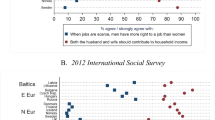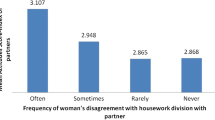Abstract.
The aim of this paper is to find an empirical connection between the striking increase in the use of fixed-term contracts in Spain and the observed delay in the age at marriage and maternity. Using the eight waves of individual information from the European Household Panel for Spain, we find that for men, the decision whether to get married is strongly negatively affected by holding unstable contracts or not working, relative to when an indefinite contract is held. However, for women, results suggest that holding fixed-term contracts is not a deterrent for the decision whether to get married. With respect to the decision of whether to enter into parenthood, results indicate that for all childless women, either with no partner, holding fixed-term contracts delays entry into motherhood relative to the holding of indefinite contracts. The discouragement effect is stronger for women with no partner, though.
Similar content being viewed by others
Explore related subjects
Discover the latest articles and news from researchers in related subjects, suggested using machine learning.References
Ahn Mira. (2001) ArticleTitle‘‘Job Bust, Baby Bust Evidence from Spain’‘ Journal of Population Economics 14 IssueID3 505–522
G.S. Becker H.G. Lewis (1973) ArticleTitle‘‘On the Interaction Between Quantity and Quality of Children’‘ Journal of Political Economy 81 s143–s288
Bentolila, S. and J. Dolado. (1994). ‘‘Labor Flexibility and Wages: Lessons from Spain’’. Economic Policy 54–99.
A. Cigno J. Ermisch (1989) ArticleTitleA Microeconomic Analysis of the Timing of Births European Economic Review 33 737–760
A. Cigno (1991) Economics of the Family Clarendon Press Oxford
B. Dankmeyer (1996) ArticleTitle‘‘Long-Run Opportunity-Cost of According to Education of the Mother in the Netherlands’‘ Journal of Population Economics 9 349–361 Occurrence Handle10.1007/s001480050022
S. De la Rica (2004) ArticleTitle‘‘Wage Gaps Between Workers with Indefinite and Fixed-term Contracts: The Impact of Firm and Occupational Segregation’‘ Moneda y Crédito 219 43–69
M. Francesconi (1998) ArticleTitle‘‘A Joint Dynamic Model of Fertility and Work of Married Women’‘ Journal of Labor Economics 20(2) 336–380
Güell, M. and B. Petrongolo. (1998). ‘‘The Transition of Workers from Fixed-term to Permanent Employment: The Spanish Evidence’’. Working paper 98–91, Department of Economics, University Carlos III, Madrid.
S. S. Gustafsson C. Wetzels J.D. Vlasblom S. Dex (1996) ArticleTitle‘‘Women’s Labour Force Transitions in connection with childbirth: A Panel Data comparison between Germany, Sweden and Great Britain’‘ Journal of Population Economics 96(3) 223–246
S. Gustafsson (2001) ArticleTitle‘‘Optimal Age at Parenthood: Theoretical and Empirical Considerations on Postponement of Maternity in Europe’‘ Journal of Population Economics 14 225–247
Gutierrez-Domènech, M. (2002). ‘‘Employment Penalty after Motherhood in Spain’’. CEP Discussion Paper, Centre for Economic Performance, LSE, CEPDP0546.
Hernanz, V. (2002). El trabajo temporal y la segmentació n: Un estudio de las transiciones laborales, PhD Dissertation, Universidad de Alcalá.
V. J. Hotz J. A. Klerman R. A. Miller (1997) ‘‘The Economics of Fertility in Developed Countries’’. Amsterdam, pp. 275–347 In M.R. Rosenzweig and O. Stark, (eds.), Handbook of Population and Family Economics, Elsevier
(Instituto Nacional de Estadística.- Banco de datos TEMPUS).
S. Jenkins (1995) ArticleTitle‘‘Easy Estimation Methods for Discrete-time Duration Models’‘ Oxford Bulletin of Economics and Statistics 57(1) 129–138
J. F. Jimeno L. Toharia (1993) ArticleTitle‘‘The Effects of Fixed term Employment on Wages: Theory and Evidence from Spain’‘ Investigaciones Economicas 17 475–494
H. Joshi (1990) ArticleTitle‘‘The Cash Alternative Costs of childbearing: An approach to Estimation using British Data’‘ Population Studies 44 41–60 Occurrence Handle10.1080/0032472031000144376
H. Joshi (1994) ‘‘The Foregone Earnings of Europe’s Mothers’‘ Observation and Analysis London: John Libbey, pp. 101–134 In Ekert-Jaffé (ed.), Standards of Living and Families
H. Joshi (1998) ArticleTitle‘‘The Opportunity Costs of Childbearting: More than Mother’s business’‘ Journal of Population Economics 11 161–183
Kalwij, A. S. (1999). ‘‘Female Employment and Fertility Decisions: An Analysis of the Effects of Household Financial Wealth’’. mimeo, Institute of Economics and StatistisUniversity of Oxford.
Kiefer, N. M. (1988). ‘‘Economic Duration Data and Hazard Functions’’. Journal of Economic Literature XXVI, 646–679.
Kugler, A., J. F. Jimeno, and V. Hernanz. (2002). ‘‘Employment Consequences of Restrictive Permanent Contracts: Evidence from Spanish Labor Market Reforms’’. Discussion Paper, No. 657.
Segura, J., F. Durán, L. Toharia, and S. Bentolila. (1991). Analisis de la contratación temporal en España, Colección Economía y Sociología del Trabajo, Ministerio de Trabajo y Seguridad Social, Madrid, Centro de Publicaciones.
L. Toharia (1996) ArticleTitle‘‘Empleo y paro en España: Evolución situación y perspectivas’’.Ekonomiaz 35 36–67
L. Toharia M. Malo (1999) ‘‘The Spanish Experiment: Pros and Cons of the Flexibility at the Margin’’. Oxford University Press (eds.), Why Deregulate Labor Markets, chapter 11, In Esping-Andersen and M. Regini, Oxford
J. Walker (1995) ArticleTitleThe Effect of Public Policies on Recent Swedish Fertility Behaviour Journal of Population Economics 8 223–251
Author information
Authors and Affiliations
Corresponding author
Additional information
JEL classification: D1, J1
Rights and permissions
About this article
Cite this article
Rica, S.D.L., Iza, A. Career Planning in Spain: Do Fixed-term Contracts Delay Marriage and Parenthood?. Rev Econ Household 3, 49–73 (2005). https://doi.org/10.1007/s11150-004-0979-8
Received:
Accepted:
Issue Date:
DOI: https://doi.org/10.1007/s11150-004-0979-8




